As most of you would know by now.
There are four 1-year T-Bills a year, and the next one is coming on 25 Jan.
Given expectations over interest rate cuts in 2024.
1-year T-Bills might be a good way to lock in interest rates going forward, if you don’t need the liquidity.
Especially for CPF-OA buyers, as you minimise the lost interest from rolling over 6-month T-Bills.
Couple of questions to discuss:
- What is the estimated yield on the next 1-year T-Bills?
- Should you buy 6-month or 1-year T-Bills? What about for CPF-OA buyers?
- Are money market funds a better buy than T-Bills?
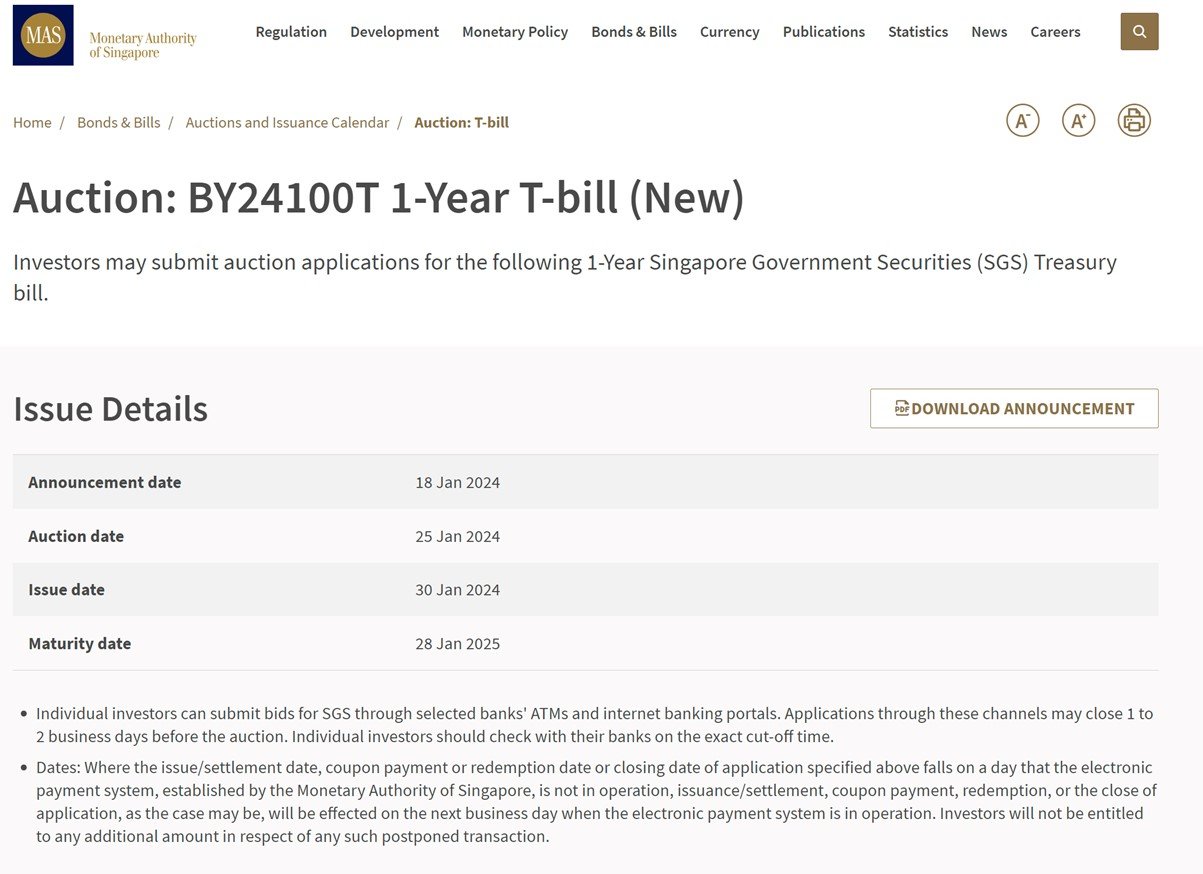
Next 1-year T-Bills auction is on 25 Jan (Thursday) – (BY24100T 1-Year T-bill)
First off – next 1-year T-Bills auction is on 25 Jan (Thurs).
This means that:
- If you’re applying in cash do apply by 9pm on 24 Jan (Wed)
- If you’re applying using CPF-OA do apply by 23 Jan (Tue)
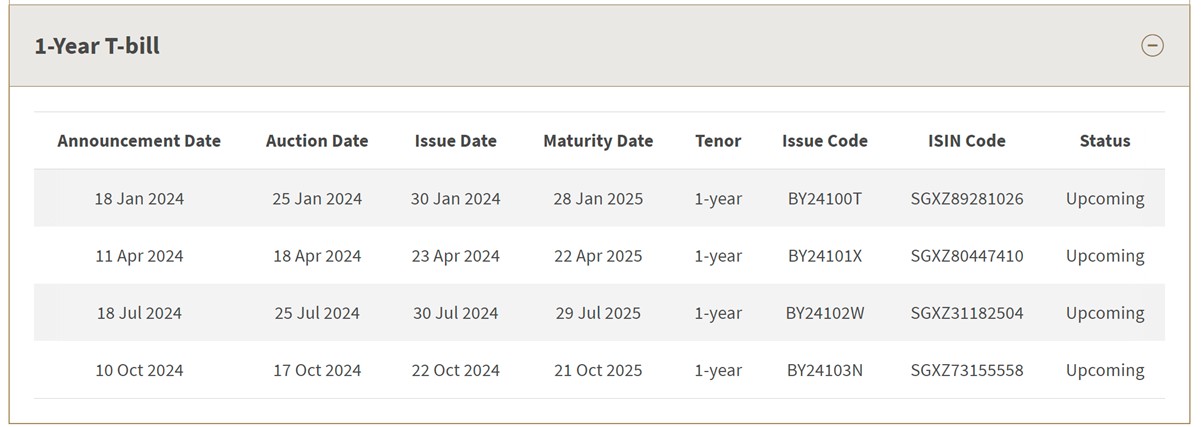
What is the estimated yield on the next 1-year T-Bills auction? (BY24100T 1-Year T-bill)
I’ll split the analysis up into 2 parts:
- Fundamentals perspective (economic growth, inflation, global interest rates etc)
- Technical perspective (supply-demand)
(1) Fundamentals perspective:
1-year T-Bills trade at 3.75% on the open market
1-year T-Bills are trading at 3.75% on the open market.
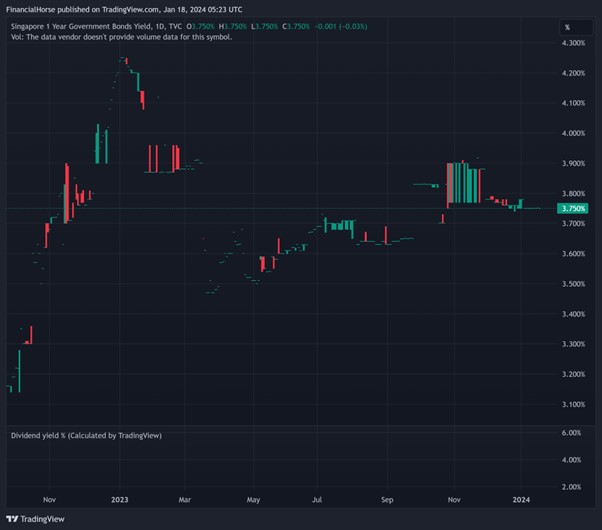
But… T-Bill trading liquidity is incredibly thin
But we’ve seen the past few auctions that trading liquidity on the T-Bills is so thin (just look at trading liquidity in the chart above) – that actually the market pricing is not that indicative.
You’ll find that the market pricing actually takes its cue from the T-Bills auction, and not the other way round.
So I would caution against placing too much reliance on market pricing on T-Bills – there just isn’t sufficient trading liquidity for true price discovery.
Huge expectations for interest rate cuts in 2024 (although this has reversed slightly)
That said – the market is overwhelmingly pricing in interest rate cuts in 2024.
The market today is pricing in 6 interest rate cuts in 2024 – a total of 1.5% in rate cuts:
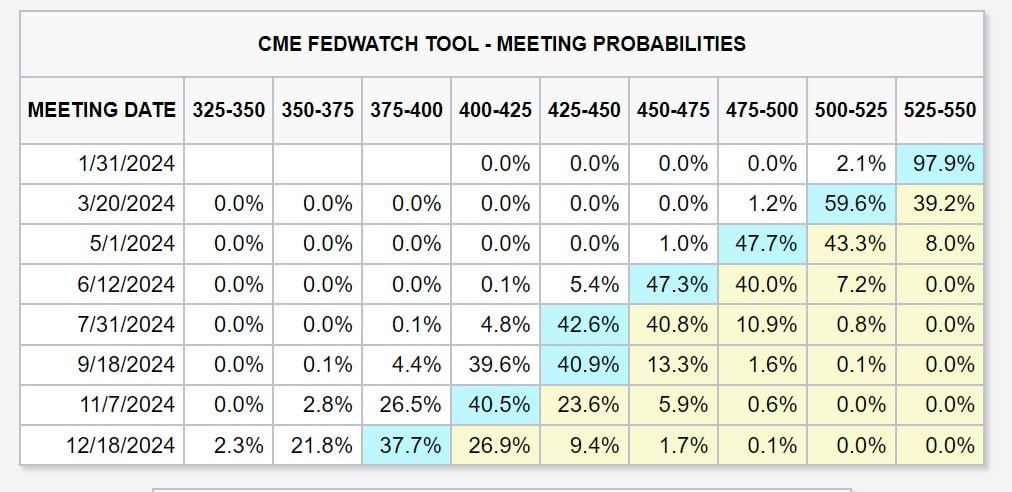
This has impacted US interest rates (and global rates) across the board.
The US 1-year yield has dropped like a rock – from 5.5% in Nov to 4.8% today:

I shared further on this in yesterday’s article.
But the long and short is that Fed officials have been trying to push back on this, to suggest to the market that if the economy stays strong they may not be able to cut as much as the market is pricing in.
This has caused a small rebound in interest rates, as you can see in the chart above.
From a Technicals, supply-demand perspective
From a more micro perspective, what matters is the supply-demand dynamics.
T-Bills Supply is $4.5 billion (flat vs the previous auction)
Amount of 1-year T-Bills on offer is $4.5 billion, exactly the same as the previous 1-year T-Bills auction.
This is substantially lower than the amount for 6-month T-Bills auctions ($6.4 billion).
Not a great sign, as you would expect demand to be high, and yet supply is on the low side.
Demand for 1-year T-Bills might be very high – may skew yields down
Demand for 1-year T-Bills typically tends to be very high, given that there are only 4 such auctions each year.
1-year T-Bills are also very attractive for CPF-OA buyers, as you minimise the lost interest when you roll over the 6-month T-Bills.
Here is the bid-cover ratio for the past 6 auctions.
You’re looking at easily double or more demand vs the amount on offer:

Because of this, most of the previous 1-year T-Bills auctions have cut-off yields that come in below market yields.
By all indications, the same looks likely here.
Which means 3.75% might be the upper limits of the cut-off yields for this auction.
Demand for 6-month T-Bills is very high, pressuring yields
Given that there are only 4 1-year T-Bills each year, let’s take a look at the 6-month T-Bills to give us an idea of market demand.
In the latest 6-month T-Bills auction, demand remains very strong.
At $13.6 billion, it comes in 6.25% higher than the previous auction.

Causing T-Bills yields to slide to 3.7% (vs 3.74% the previous auction):
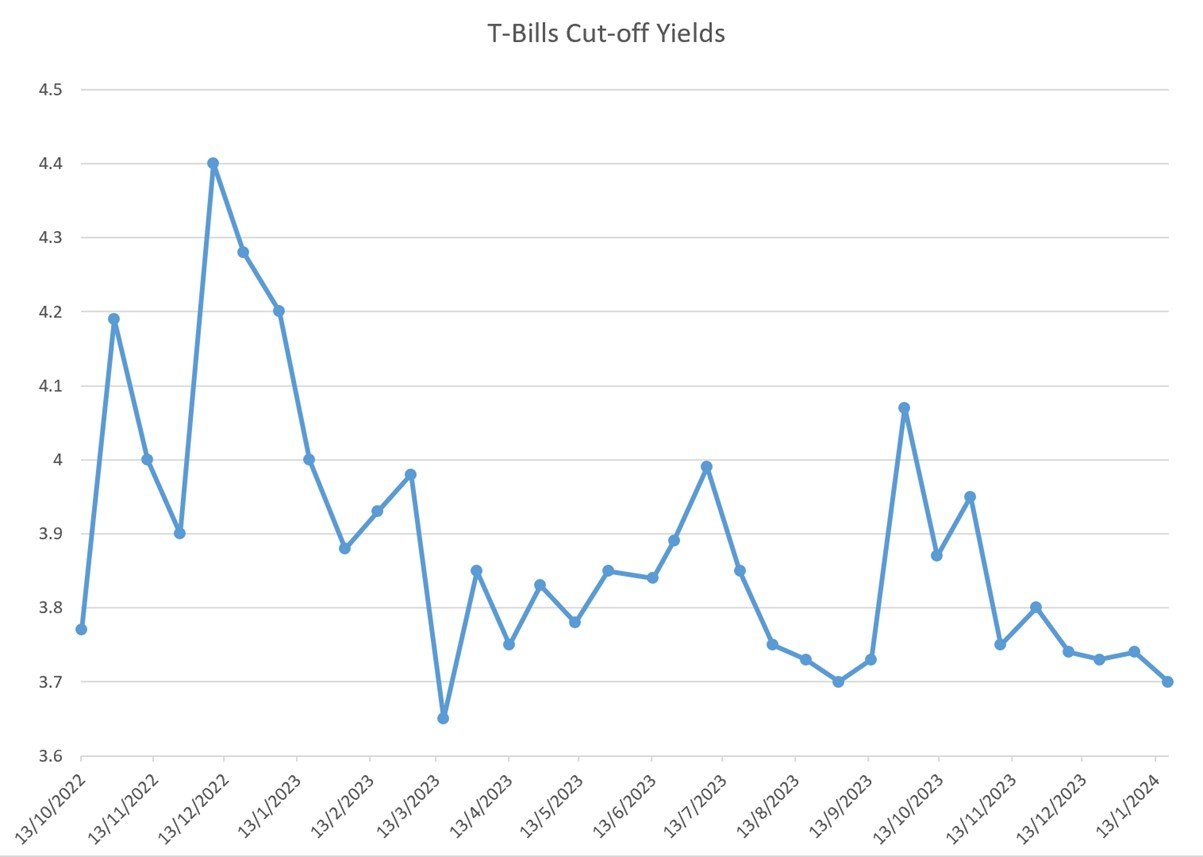
While spread between median and average yield remains very high – indicating strong / inelastic demand for T-Bills.

Estimated yield of 3.65% – 3.75% on the 6-month T-Bills auction? (BY24100T 1-Year T-bill)
Putting it altogether.
Market is pricing in 6 interest rate cuts in 2024.
However SGD interest rates have been generally stable.
Demand for 1-year T-Bills tends to be very high, and we don’t see anything that would indicate otherwise this auction.
Demand for 6-month T-Bills remains very high too, and we may see some of that demand spill over.
All while the amount of T-Bills on auction isn’t that high – $4.5 billion being flat vs the previous auction.
Given all of the above – I think the 3.75% market yield on the 1-year T-Bills may prove to be the higher end of the anticipated range.
I would probably go with an estimated yield of 3.65% – 3.75% on the next 1-year T-Bills auction.
Are 1-year T-Bills a much better buy than 6-month T-Bills?
Interest rate cuts in 2024 are a near certainty at this point.
The question is how many, and how quickly.
But looking at the above, it generally looks like you can get 1-year T-Bills at yields very close to the 6-month T-Bills.
In which case I would say if you don’t need the liquidity, the 1-year T-Bills might be a pretty good buy actually.
The risk is if interest rates go up in 2024, but given that rate hikes are off the table, this should help reduce the risk.
What about for CPF-OA buyers?
With CPF-OA buyers, the 1-year T-Bills are even more attractive because:
- You lock in interest rates for the next 1-year (in fact you get the interest upfront)
- You minimise the lost interest from when you roll over 6-month T-Bills
So I can see a lot of CPF-OA buyers going for this 1-year T-Bills.
Which perversely, has the potential to skew yields down.
So you might want to consider putting in a competitive bid, just in case there is a freak result.
Maybank now has a CPF Fixed Deposit – 2.9%
Do note that Maybank now has a CPF Fixed Deposit.
However the interest rate at 2.9% is not attractive at all, so you’re still better off using buying T-Bills.

Should you submit a competitive or non-competitive bid?
I usually encourage investors to submit a competitive bid (just in case there is a freak result and yields drop a lot).
And submit as close to the deadline as you can, so you can take a look at where market pricing is at that time before deciding on your bid.
But I know some investors really don’t like competitive bidding.
In which case non-competitive bidding is probably fine as well.
But do note that with non-competitive, if there is a freak result and yields drop to 3.0%, you are still forced to buy.
What yield to submit with competitive bidding?
Some of you have asked how to approach competitive bidding for T-Bills.
Apparently there are others out there who are advocating for submitting low bids like 1.5% just to ensure you get an allotment.
I don’t really agree with that kind of reasoning, and if everyone were to do that you’ll see T-Bills close at ridiculously low yields.
I would say to think about the minimum yield you are prepared to buy the T-Bills.
Let’s say any yield below 3.60% and you would prefer to just go with 6-month T-Bills instead.
Then a competitive bid around the 3.60% range may make sense.
Don’t forget that you can submit multiple bids.
So you can submit a bid for $20,000 of T-Bills at 3.60%, and another $10,000 at 3.80%.
This allows you to buy more T-Bills if yields close high, and yet still get some if yields close low.
There is no application fee for T-Bills bids using cash, so this isn’t an issue (but not the case for CPF-OA).
Are 1-year T-Bills still worth buying vs Money Market Funds, Singapore Savings Bonds or Fixed Deposit or Savings Accounts?
BTW – we share commentary on Singapore Investments every week, so do join our Telegram Channel (or Telegram Group), Facebook and Instagram to stay up to date!
Don’t forget to sign up for our free weekly newsletter too – with weekly roundups every Sunday!
Money Market Funds pay about 3.8% – 4.1% yield – but not risk free, and yields can change any time
With the drop in T-Bills yields, Money Market Funds are actually pretty competitive these days.
Mari Invest, which is the money market fund solution via Mari Bank in a tie up with Lion Global, pays about 3.8% – 4.1% (exact yield fluctuates over time).
Likewise Fullerton SGD Cash Fund pays about 3.6% – 3.9%.
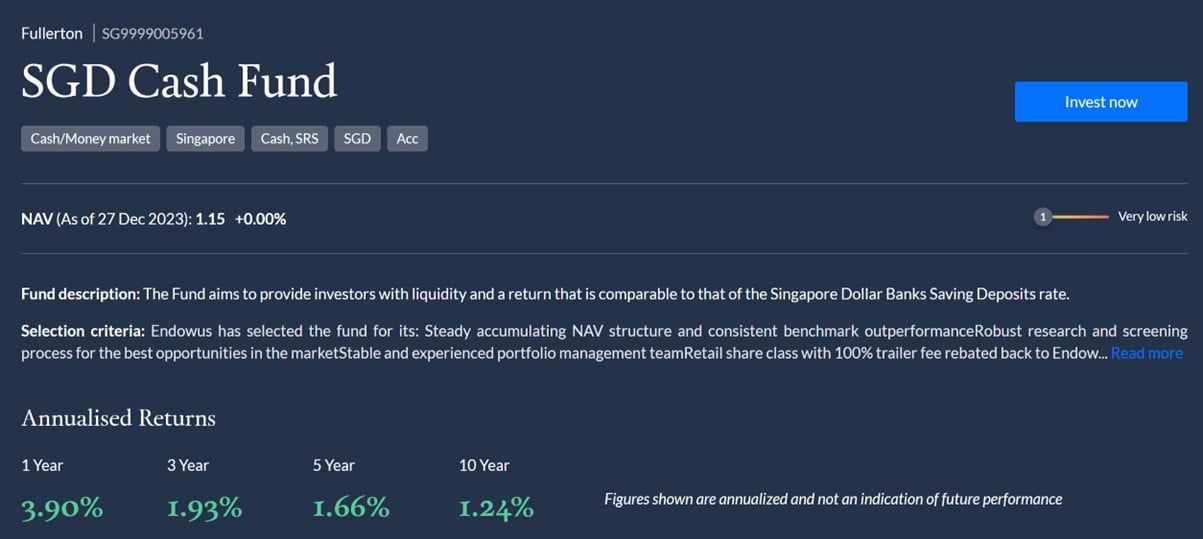
Money Market Funds are technically not risk free though – so this is a big point to note.
And Money Market Funds invest in short term instruments, so the interest rates will fluctuate from time to time.
This is unlike a 1-year T-Bill where you are “locking in” interest rates for the full 1-year.
The benefit though, is that you can get your money back with T+1 liquidity, which is a big plus vs T-Bills
I personally have started putting some cash into Money Market Funds instead of T-Bills, due to the liquidity benefits and yields that are competitive vs T-Bills.
It’s about finding the right mix between Money Market Funds and 6 or 1-year T-Bills.
Best Fixed Deposit option? Bank of China pays 3.30% for 1-year
The best Fixed Deposit option I could find today is Bank of China which pays 3.30% for 1-year.
It’s not great, and you’re probably better off just buying T-Bills.

Singapore Savings Bonds are not an attractive buy – 2.72% for 1-year
Yields on the latest Singapore Savings bonds are:
- 2.72% for the first 7 years
- 2.81% for 10 years

I don’t think SSBs are that attractive anymore given that most investors should have locked in the 3%+ yields just a few months back.
If you want something for 1-year, T-Bills will probably give you a higher yield.
Picking between 1-year T-Bills vs 6-month T-Bills, Money Market Funds, Singapore Savings Bonds, Fixed Deposit and Savings Accounts?
I would say if you want the highest yield for a locked in 1-year period, T-Bills are probably your best bet.
The other options like Singapore Savings Bonds and Fixed Deposit are unlikely to match the yields on T-Bills.
If you’re okay with something shorter term though – then the 6-month T-Bills or Money Market Funds are good alternatives.
Money Market Funds today actually offer higher yields than T-Bills, but the drawback is that they are not risk free, and yields fluctuate based on market yields.
I would say as an investor today, you probably want to spread your cash over a mix of:
- High Yield Savings Accounts (eg. UOB One)
- Singapore Savings Bonds
- T-Bills
- Money Market Funds
The right mix will depend on your liquidity requirements (and on liquidity – I would say err on the side of caution. You rather have more liquidity than not enough liquidity).
Once you know how much liquidity you need, you just pick the combination that maximises your yield / interest rate.
This article was written on 19 Jan 2024 and will not be updated going forward.
For my latest up to date views on markets, my personal REIT and Stock Watchlist, and my personal portfolio positioning, do subscribe for FH Premium.
WeBull Account – Get up to USD 3000 worth of shares
I did a review on WeBull and I really like this brokerage – Cheap US Stock, Options and ETF trading, in a very easy to use platform.
I use it for my own trades in fact.
They’re running a promo now.
You can get up to USD 3000 free shares.
You just need to:
- Sign up for a WeBull Account here
- Fund USD 500
- Subscribe for Moneybull (the money market fund solution) and maintain for 30 days
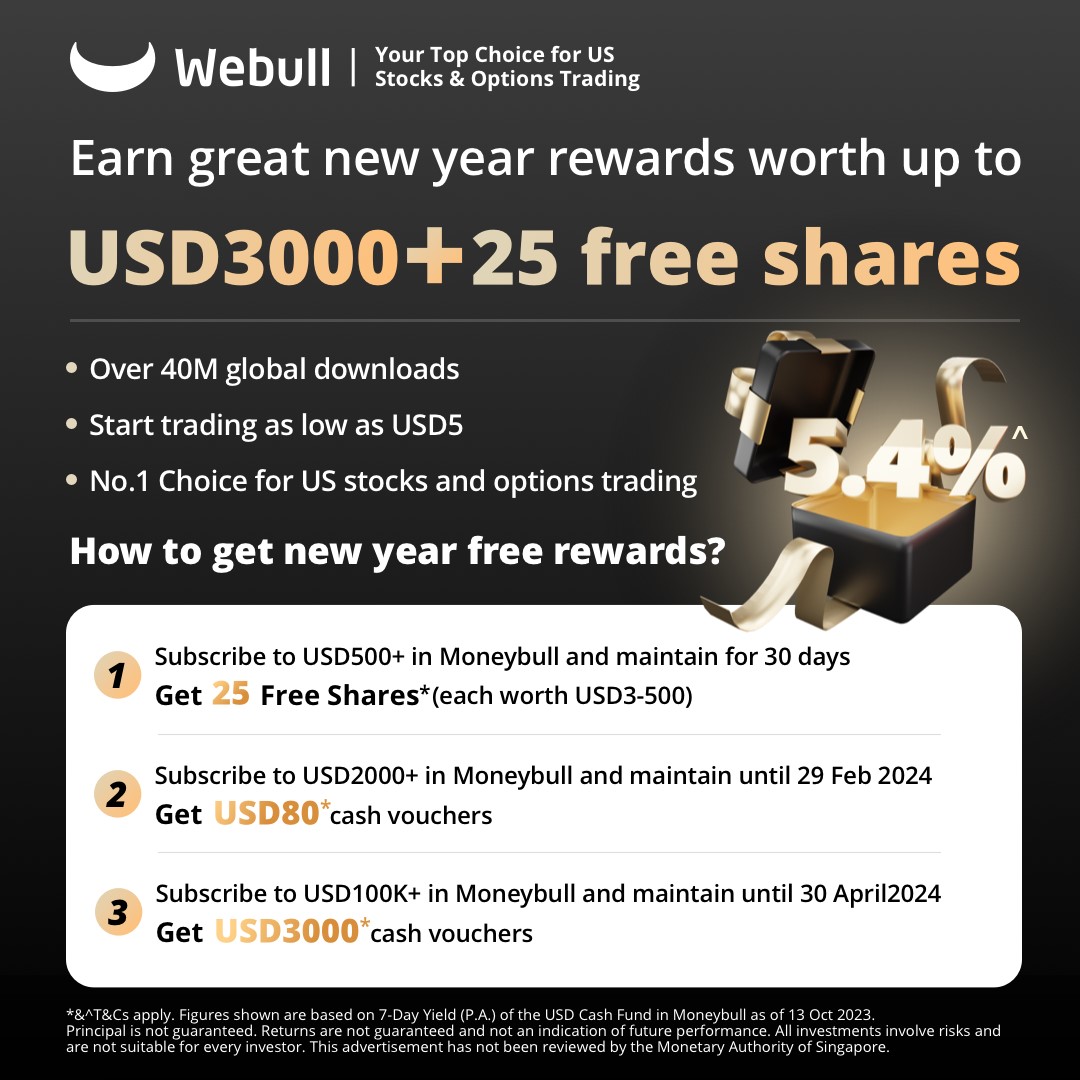
OCBC Online Equities Account – Trade on 15 global exchanges, all via the OCBC Digital Banking App!
Did you know that can you trade shares on your OCBC Digital Banking App?
With an OCBC online equities account, you can buy stocks, local ETFs, REITs, bonds and more directly through your banking app.
Even better? Enjoy reduced commission rates of just 0.05% for buy trades on SG, US and HK market until 31 December 2023.
Everything on one app! Fuss-free funding, with access to 15 global exchanges
For SGD trades, you can fund and settle automatically via your OCBC account.
And for FX trades, you can settle using the foreign currency held in your OCBC Global Savings Account.
This means fuss-free trade settlement and minimising forex costs – saving you time and money.
Start trading with your OCBC Online Equities Account here!
Trust Bank Account (Partnership between Standard Chartered and NTUC)
Sign up for a Trust Bank Account and get:
- $35 NTUC voucher
- 1.5% base interest on your first $75,000 (up to 2.5%)
- Whole bunch of freebies
Fully SDIC insured as well.
It’s worth it in my view, a lot of freebies for very little effort.
Full review here, or use Promo Code N0D61KGY when you sign up to get the vouchers!
Portfolio tracker to track your Singapore dividend stocks?
I use StocksCafe to track my portfolio and dividend stocks. Check out my full review on StocksCafe.
Low cost broker to buy US, China or Singapore stocks?
Get a free stock and commission free trading Webull.
Get a free stock and commission free trading with MooMoo.
Get a free stock and commission free trading with Tiger Brokers.
Special account opening bonus for Saxo Brokers too (drop email to [email protected] for full steps).
Or Interactive Brokers for competitive FX and commissions.
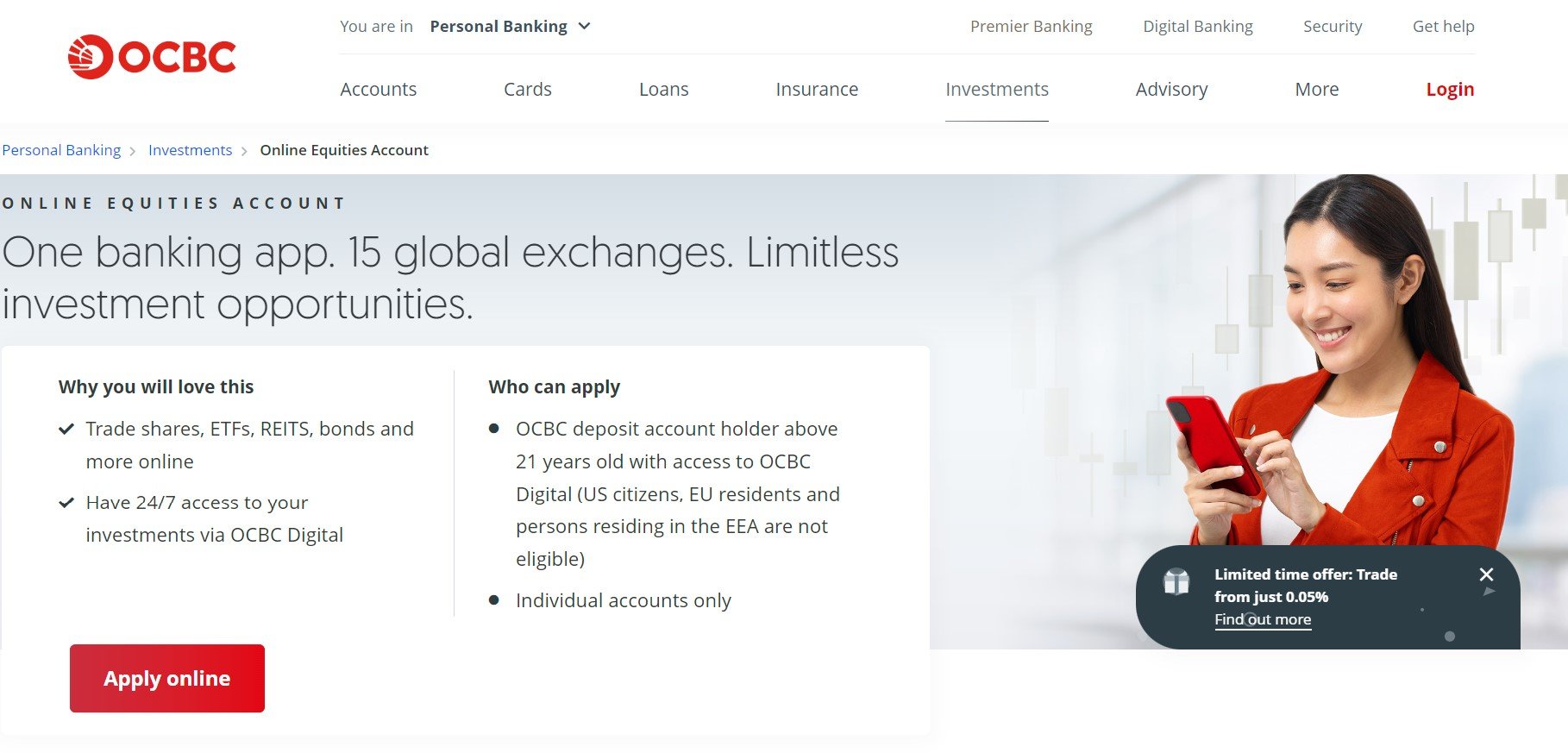
will lose 8 mths of CPF interest if subscribe to this round of 1 year Tbill. correct?
This is a 1 year T-Bill.
So you will lose up to 14 months CPF interest, depending on what you do with the funds on maturity. If you can roll over into new T-Bills, it minimises the interest lost.
Correct. Provided you refund the CPF investment Maturity amount back to cpf board without delay ???? ???? ????
It’s pretty quick these days. Last I tried with DBS – money was back in CPF-OA the next day.
Good read. Currently, there are a lot of other products out there like FD, Tbill, SSB and even cash management account. How do you know which one to use and how much % to put in?
I suggest to think about how much liquidity you need. Then you set that amount of liquidity aside, ideally with some buffer. The rest goes into the highest yielding instruments you have, at the level of risk.
You have got the T-bills wrong so many times!
My apologies – the projected ranges are meant as a guide for investors, and not set in stone. If demand for individual auction is very high – you may see yields drop like we did for this auction. Which is why I suggest that investors put in a competitive bid to avoid any freak results.